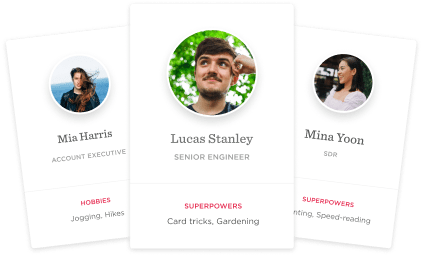The best HRMS software for scaling teams
Focus on empowering the people who are growing your team so you can drive productivity, engagement, and retention.











Automate your core HR management functions so you can reduce paperwork and focus on your team.
I strive to implement automation in every possible aspect of HR and Bob helped us to achieve this. I also felt that there was a great fit between the culture of our company and the culture of Bob, with its innovative, young, and fresh approach.


Bob’s centralized HRMS brings all your HR processes together in a unified social media-like platform.


Let your HR leaders focus on their people, not manual work. Bob’s People Analytics provides HR teams with insights for pushing strategic growth.


Bob’s HRMS centralizes the management of attendance, leave, and payroll to ensure accuracy across the entire organization.


Manage the onboarding process with unlimited customizable flows. Bob’s HRMS ensures higher retention by creating a personalized experience for every new hire.
Being a global organization and using Bob’s flows and task lists means that I’m able to customize onboarding to each geographical location based on what their specific needs are or what that specific office set-up is like. So, for example, if one of our offices doesn’t have a facilities manager, I can assign the function to the receptionist instead.


Bob’s HRMS focuses on supporting your team members’ professional growth through comprehensive performance reviews and strategic workforce planning. Help every person reach their full potential while aligning their efforts with your organization’s objectives.
The term “HRMS” stands for human resources management system, so saying “HRMS system” is technically redundant. An HRMS system integrates various HR functions into one platform, including payroll, benefits, employee data, recruitment, onboarding, and performance reviews.
HRMS allows HR teams to efficiently manage the entire employee lifecycle and provide a better experience for every team member. HR leaders can use HRMS to free up valuable time, allowing them to focus on company culture rather than paperwork.
HR leaders turn to HRMS for several key benefits, such as reducing manual paperwork, minimizing human errors, and simplifying daily tasks like payroll and attendance tracking. HR teams also make informed decisions using the systems’ real-time data and analytics.
These advantages free up more time for HR to engage directly with their teams to increase employee satisfaction and retention.
Yes, different types of HRMS solutions cater to different needs. Some systems focus on core HR functions like payroll, benefits, and time tracking, while others offer advanced features like talent management, performance reviews, absence management, and workforce analytics. Other HRMS platforms also integrate with other business tools to provide a more comprehensive approach to managing your workforce.
Bob’s HRMS key features include:
To choose an HRMS, start by evaluating your team’s specific needs, such as scalability, integration capabilities, and user-friendliness. Then, look for a solution that offers key features that improve your operations, such as automated workflows, centralized data management, and advanced analytics.
Verify that the HRMS aligns with your company’s goals and can adapt as your business grows. You might also consider the level of support and ongoing updates provided by the vendor to guarantee long-term success with the system.
HRMS, HRIS, and HCM all refer to systems that manage HR functions, but they have different focuses. HRIS (human resources information system) primarily handles data management and administrative tasks like payroll and record-keeping.
HRMS (human resources management systems) include HRIS functionalities but also add features like performance management and provide tools to maximize employee engagement.
HCM (human capital management) takes a broader approach, focusing on strategic HR functions like talent and workforce management. Each system caters to different HR needs depending on an organization’s goals.
Yes, many HRMS solutions include payroll automation as a core component. An HRMS typically integrates payroll management with other HR functions like time tracking, attendance, and benefits administration to ensure accurate and efficient payroll processing. HR leaders can automatically sync data across the platform to reduce errors and save valuable time.
HRMS software begins with the purchase and implementation phase when the system integrates with your existing HR infrastructure. During this time, HR leaders can load data like employee records, payroll details, and benefits information into the system. HR managers then set up access controls, determining who can view or edit specific information. Once configured, HR can begin to automate daily tasks, such as attendance tracking, onboarding, report generation, or whatever they choose is best for their team.
